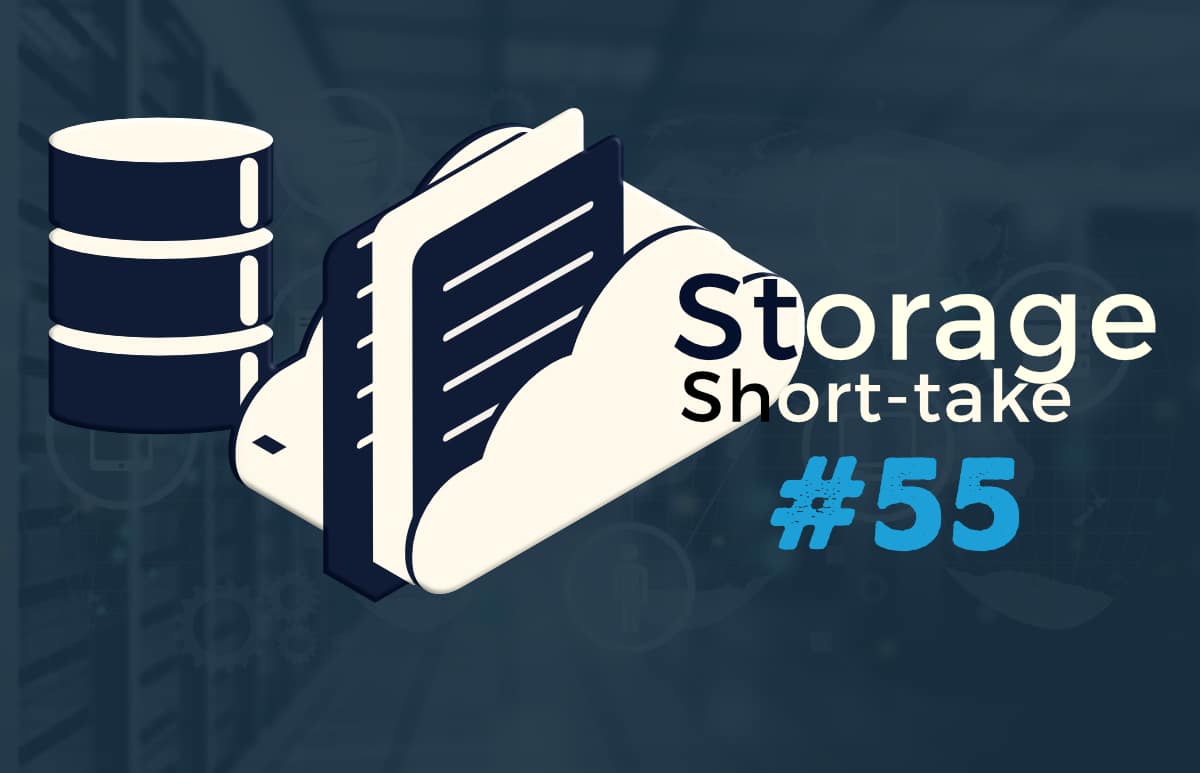
This is likely the penultimate Short Take for 2022, and has several interesting pieces.
As always, links are live at time of publication.

Storage Media and Technology
Seagate has announced a HDD that's as fast as a SATA SSD. The key difference are the dual-actuators that work in parallel cut down access times. It's not as fast as NVMe, but it's faster than typical HDDs and has the capacity advantages over SSDs. Could it be the sweet spot needed?
EETimes has a good article on Computational Storage and CXL.
ArchitectingIT has a good article laying out the land about Data Security, Ransomware, and Data Protection.
NextPlatform asks a very important question - Just How Bad is CXL Memory Latency? It's important because CXL has the potential to change the way we look at Memory and Memory access as part of systems, rather than simply being tethered to a host processor. It's worth an examination in depth at a later date.
Rainer W. Kaese, Sr. Manager of HDD Business development from Toshiba, wrote a neat article on the 40 Years of HDD Technology.
Timothy Prickett Morgan asks, "Can Anyone Make Money From Modern Storage?" Given that it's TPM, you know that you're going to get some pretty unique and insightful analysis.
SKhynix has figured out a way to boost DDR5 DRAM speed by using parallel reads from the memory banks. The primary use case appears to be HPC applications.
Storage Companies in the News
Gigaom has published it's Radar for Distributed Cloud File Storage. According to their analysis, Hammerspace has made a major move for the better.
Dropbox acquires Boxcryptor (a German Cloud Security company). Maybe they'll finally have decent security built-in.
HPE is in talks to buy Nutanix. Now there is a culture clash if ever there was one.
Micron has launched its 232-layer SSDs for client systems (i.e., PCs). It's PCIe 4 x4 systems that have much lower power draws. The read/write performance is pretty spectacular as well. Tom Coughlin wrote a take on Forbes as well. His take is that it's showing promise on the trend of better capacity, performance, and power consumption per dollar.
Blocks and Files did a great job summarizing many of the announcements from AWS re:Invent.
Fungible has been acquired, though they're staying mum on the details for now.
Synology has announced an "important" security vulnerability reported by PWN2OWN TORONTO 2022. If you're running DSM 7.1, you'll want to upgrade. Earlier versions are still ongoing.
Whether you think the "Metaverse" will succeed or be a Billion-dollar bust, there's no question that companies are falling over themselves to show how prepared they are for it. Samsung is the latest out of the gate to talk about "graphics memory" technology. Despite the rah-rah aspect, there are still a few gems of information in there.
Industry Associations and Standards
The new SNIA Matters newsletter is out, which includes the publication of SDXI (Smart Data Accelerator Interface) 1.0, Multicloud technical white paper, Storage Security standards, and Zoned Storage Models feedback.
My SNIA colleague Richelle Ahlvers has a conversation with Phil Alsop of Digitalisation World about Swordfish, the Storage Management standard.:
Every year SNIA honors the outstanding effort that members make to the storage community by recognizing their hard work. If someone you know has been contributing to SNIA in a meaningful way, please consider nominating them for a recognition award.
Webinars, Blogs, and Conferences
Jim Handy discusses the longevity (and the question that surrounds it) of SATA. Personally, I have to wonder about the long-term implications that NVMe-HDDs will have once those products hit the market. When I was building my latest gaming machine, I lamented the fact that it would have been so much easier to tap into the available PCIe lanes for HDD capacities...
Kava Kushnoor of Intel has a really interesting benchmarking blog of using the HammerDB PostgreSQL OLTP workload comparing direct-attached storage (DAS) to LightBits Labs NVMe/TCP. I won't spoil the ending, but it's pretty impressive.
Tom Coughlin has written an article for Forbes that has - without question - the most technical title for a popular publication I've ever seen. "Samsung MRAM, Imec FeRAM, CEA Leti RRAM Neuromorphic Computing At The 2022 IEDM." I'm not going to lie - it's not exactly an approachable article, but I'm including it here as a reference for future decryption.
The 2023 SNIA Preview is a virtual event on January 18, 2023, that will highlight the accomplishments and future plans of SNIA's technical work groups (TWGs), Forums and Initiatives (F&I), Committees, and Technical Affiliates (TA). It's open to the public and is a great opportunity to get an inside perspective on future storage technologies, including computational storage, DNA Data Storage, non-volatile memory, and more.
Enrico Signoretti has an interesting take on the changing meaning of "data protection." He cautions that the discussions must necessarily become more complicated, but I don't think this is a bad thing. What he's talking about is that there are many inter-dependencies that cause unintended consequences, and that there is no panacea for protecting your data. I think it's a good thing that he's working to raise this in peoples' consciousness.
Bonus Round
Another classic from the past. It appears these blasts from the past are pretty popular, so here we have Bob Newhart's The Driving Instructor. It's audio only, but well worth the 8 minutes.
